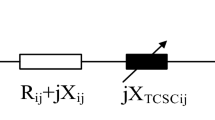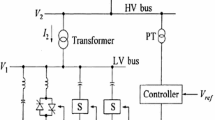Abstract
This paper introduces a new partitioned ant lion optimizer (PALO) strategy to improve the solution accuracy and quality of the optimal power flow (OPF) considering multi Static VAR Compensator (SVC) and Thyristor Controlled Series Controller (TCSC)-based FACTS devices. An interactive partitioning structure-based ALO is proposed to improve the solution of OPF by creating an interactive equilibrium between diversification and intensification during the search process. The decision variables such as active power, voltage magnitudes of generating units, tap transformers; reactive power of Static VAR Compensator (SVC), and the reactance of TCSC devices are optimized using a flexible partitioned process. Three objective functions, such as total fuel cost, total power loss, and total voltage deviation have been optimized considering load growth. The robustness of the proposed PALO has been validated on three test systems, the IEEE 30-bus, and two large test systems, the 300-bus and 2736 ps bus of the Polish power system. Results compared to many recent techniques prove the particularity and competitiveness of the proposed optimization strategy-based PALO.




















Similar content being viewed by others
Abbreviations
- \(F_{{{\text{cost}}}}\) :
-
Objective function for fuel cost minimization
- \(F_{{{\text{ploss}}}}\) :
-
Objective function for power loss minimization
- \(F_{{{\text{VD}}}}\) :
-
Objective function for voltage deviation
- \(F_{{\text{ploss,VD}}}\) :
-
Objective function for power loss and voltage deviation
- \(F_{{\text{VD,Norm}}}\) :
-
Normalized objective function for voltage deviation
- \(H\left( {\text{SV,CV}} \right)\) :
-
Equality constraints
- \(G\left( {\text{SV,CV}} \right)\) :
-
Inequality constraints
- \(F{}_{{\text{Cost } - \text{ VD}}}\) :
-
Combined objective function for fuel cost and voltage deviation minimization
- \(F_{{{\text{Kl}}}}\) :
-
Objective function for loading margin stability maximization
- \({\text{SV}}\) :
-
Vector of state variables
- \({\text{SC}}\) :
-
Vector of control variables
- \({\text{Kl}}\) :
-
Loading factor
- \(\beta\) :
-
Penalty factor
- \(V_{{{\text{ref}}}}\) :
-
Reference voltage, taken equal 1 p.u.
- \(S_{{{\text{load}}}}^{{{\text{new}}}} \,\) :
-
New apparent power at load bus
- \(S_{{{\text{load}}}}^{{{\text{base}}}}\) :
-
Base apparent power at load bus
- \(V_{{{\text{Gi}}}}^{{\min}}\),\(V_{{{\text{Gi}}}}^{\max }\) :
-
Voltage magnitude limits at PV buses
- \(P_{{{\text{Gi}}}}^{\min }\),\(P_{{{\text{Gi}}}}^{\max }\) :
-
Active power limits of generators
- \(Q_{{{\text{Gi}}}}^{\min }\), \(Q_{{{\text{Gi}}}}^{\max }\) :
-
Reactive power limits of generators
- \(P_{Gs}\), \(Q_{Gs}\) :
-
Active and reactive power of slack bus
- \(T_{i}^{\min }\),\(T_{i}^{\max }\) :
-
Limits on the regulating transformers
- \(N\) :
-
Number of bus
- \({\text{NG}}\) :
-
Number of generators
- \({\text{Nt}}\) :
-
Number of regulating transformers
- \({\text{Npq}}\) :
-
Number of load buses
- \({\text{Npv}}\) :
-
Number of generator buses
- \({\text{Nl}}\) :
-
Number of transmission lines
- \({\text{Nsh}}\) :
-
Number of shunt compensators
- \({\text{Nsvc}}\) :
-
Number of SVC
- \(B_{{^{{{\text{SVC}}}} }}^{{\min}}\), \(B_{{^{{{\text{SVC}}}} }}^{{\max}}\) :
-
Susceptance limits of SVC compensators
- \(V_{{{\text{Li}}}}^{{\min}}\), \(V_{{{\text{Li}}}}^{{\max}}\) :
-
Voltage magnitude limits at PQ buses
- \(S_{{{\text{li}}}}^{{\max}}\) :
-
Maximum transmission line loading
- \(P_{{{\text{Di}}}}\),\(Q_{{{\text{Di}}}}\) :
-
Active and reactive power demand at ith bus
- \(G_{ij}\),\(B_{ij}\) :
-
Conductance and susceptance of the i–jth elements in the bus admittance matrix
- \(\theta_{ij}\) :
-
Angle difference between buses \(i\) and \(j\)
- \(V_{i}\), \(V_{j}\) :
-
Voltages at buses \(i\),\(j\)
- \(Q_{i}^{{{\text{SVC}}}}\) :
-
Reactive power of SVC installed at ith bus
- \(L\max\) :
-
Maximum voltage stability index
- \(L - index\) :
-
Voltage stability index
- FACTS:
-
Flexible AC transmission systems
- SVC:
-
Static VAR compensator
- TCSC:
-
Thyristor controlled series controllers
- GWO:
-
Grey wolf optimizer
- ALO:
-
Ant lion optimizer
- PALO:
-
Partitioning ant lion optimizer
- TPL:
-
Total power loss
- TVD:
-
Total voltage deviation
- LMS:
-
Loading margin stability
- ORPP:
-
Optimal reactive power planning
References
Dommel HW, Tinney TF (1968) Optimal power flow solutions. IEEE Trans Power Appar Syst 87(5):1866–1876
Belkacem Mahdad K (2015) Srairi Blackout risk prevention in a smart grid based flexible optimal strategy using Grey Wolf-pattern search algorithms. Energy Conv Manag 98:411–429
Alsac O, Scott B (1974) Optimal load flow with steady state security. IEEE Trans Power Appar Syst PAS-93:745–751
Burchett RC, Happ HH, Vierath DR (1984) Quadratically convergent optimal power flow. IEEE Trans Power Apparat Syst 103(11):3267–3276
Sun DI, Ashley B, Brewer B, Hughes A, Tinney WF (1984) Optimal power flow by Newton approach. IEEE Trans Power Appart Syst 103(10):2864–2875
Quantana XVH (1999) Improving an interior point based OPF by dynamic adjustments of step sizes and tolerances. IEEE Trans Power Syst 14(2):709–717
Capitanescu F (2016) Critical review of recent advances and further developments needed in AC optimal power flow. Electr Power Syst Res 136:57–68
Bouchekaraa HREH, Abidob MA, Bouchermaaa M (2014) Optimal power flow using Teaching-Learning-BasedOptimization technique. Electr Power Syst Res 114:49–59
Mirjalili S, Mirjalili SM, Lewis A (2014) Grey Wolf Optimizer. Adv Eng Softw 69:46–61
Sulaiman MH, Mustaffa Z, Mohamed MR, Aliman O (2015) Using the gray wolf optimizer for solving optimal reactive power dispatch problem. Appl Soft Comput 32:286–292
Nguyen TT (2019) A high performance social spider optimization algorithm for optimal power flow solution with single objective optimization. Energy 171(2019):218–240
Mirjalili S (2015) The ant lion optimizer. Adv Eng Softw 83:80–98
Kamboj VK, Bhadoria A, Bath SK (2015) Solution of non-convex economic load dispatch problem for small-scale power systems using ant lion optimizer. Neural Comput Appl. https://doi.org/10.1007/s00521-015-2148-9
Ali Mohamed A-A, Mohamed YS, El-Gaafary AAM, Hemeid AM (2017) Optimal power flow using moth swarm algorithm. Electr Power Sys Research 142:190–206
El-Fergany AA, Hasanien HM (2019) Salp swarm optimizer to solve optimal power flow comprising voltage stability analysis. Neural Comput Appl. https://doi.org/10.1007/s00521-019-04029-856
Pandiarajan K, Babulal CK (2016) Fuzzy harmony search algorithm based optimal power flow for power system security enhancement. Int J Electr Power Energy Syst 78:72–79
Belkacem Mahdad, Srairi K (2016) Security constrained optimal power flow solution using new adaptive partitioning flower pollination algorithm. Appl Soft Comput 46:501–522
Thang Trung Nguyen (2019) A high performance social spider optimization algorithm for optimal power flow solution with single objective optimization. Energy 171:218–240
Zhang J, Wang S, Tang Q, Zhou Y, Zeng T (2019) An improved NSGA-III integrating adaptive elimination strategy to solution of many-objective optimal power flow problems. Energy 172:945–957
Biswas PP, Suganthan PN, Mallipeddi R, Amaratung GAJ (2019) Optimal reactive power dispatch with uncertainties in load demand and renewable energy sources adopting scenario-based approach. Appl Soft Comput 75:616–632
Zhou Y, Zhang J, Yang X (2018) Ying Ling. Optimal reactive power dispatch using water wave optimization algorithm, Operational Research, pp 1–17
Roberge V, Tarbouchi M, Okou F (2016) Optimal power flow based on parallel metaheuristics for graphics processing units. Electr Power Syst Res.
Seyedali Mirjalili SCA (2016) A sine cosine algorithm for solving optimization problems. Knowl-Based Syst 96:120–133
Mahdad B, Srairi K (2017) A new interactive sine cosine algorithm for loading margin stability improvement under contingency. Electr Eng 100:913–933
V Roberge, M Tarbouchi, F Okou Parallel power flow on graphics processing units for concurrent evaluation of many networks, accepted for inclusion in IEEE Transactions on smart grid
Roberge V, Tarbouchi M, Okou F (2016) Optimal power flow based on parallel metaheuristics for graphics processing units. Electr Power Syst Res 140:344–353
Belkacem Mahdad K (2014) Srairi, Multi objective large power system planning under sever loading condition using learning DE-APSO-PS strategy. Energy Conv Manag (Elsevier) 87:338–350
Naderi E, Pourakbari-Kasmaei M, Abdi H (2019) "An efficient particle swarm optimization algorithm to solve optimal power flow problem integrated with FACTS devices. Appl Soft Comput 80:243–262
Singh M, Dutta S, Roy PK Optimal power flow with FACTS devices using a novel grey wolf algorithm. In: 2017 third international conference on science technology engineering & management (ICONSTEM). IEEE, 2017.
Bouchekara H (2019) Solution of the optimal power flow problem considering security constraints using an improved chaotic electromagnetic field optimization algorithm. Neural Comput Appl. https://doi.org/10.1007/s00521-019-04298-3
Surender Reddy S (2018) Optimal power flow using hybrid differential evolution and harmony search algorithm. Int J Mach Learn Cybernet. https://doi.org/10.1007/s13042-018-0786-9
El-Fergany AA, Hasanien HM (2018) Tree-seed algorithm for solving optimal power flow problem in large-scale power systems incorporating validations and comparisons. Appl Soft Comput. 64:307–316
Taher MA, Kamel S, Jurado F, Ebeed M (2019) Modified grasshopper optimization framework for optimal power flow solution. Electr Eng. https://doi.org/10.1007/s00202-019-00762-4
Zimmerman RD, Murillo-Sánchez CE, Thomas RJ, Matpower. https://www.pserc.cornell.edu/matpower.
Kessel P, Glavitsch H (1986) Estimating the voltage stability of a power system. IEEETrans Power Deliv 1(3):346–354
Author information
Authors and Affiliations
Corresponding author
Additional information
Publisher's Note
Springer Nature remains neutral with regard to jurisdictional claims in published maps and institutional affiliations.
Rights and permissions
About this article
Cite this article
Mahdad, B. Improvement optimal power flow solution considering SVC and TCSC controllers using new partitioned ant lion algorithm. Electr Eng 102, 2655–2672 (2020). https://doi.org/10.1007/s00202-020-01033-3
Received:
Accepted:
Published:
Issue Date:
DOI: https://doi.org/10.1007/s00202-020-01033-3




